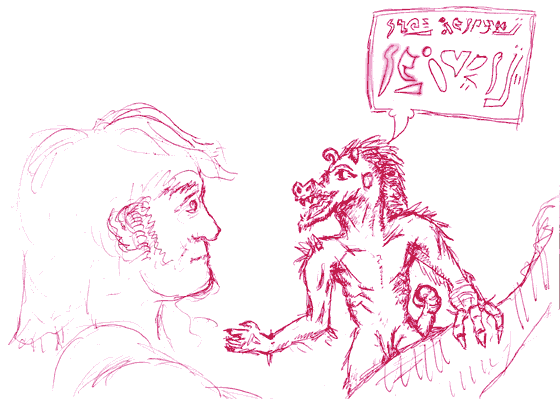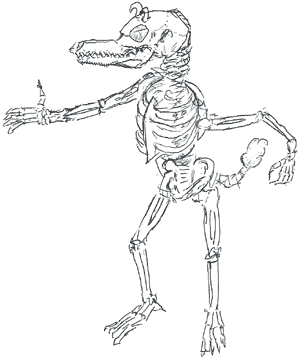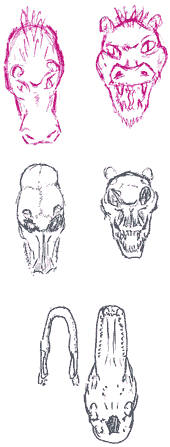 |
Introduction Site Map Email: jja@nac.net |

"I don't know. It is Odin's disk and it has only one side."
— J. L. Borges, The Disk.


Thursday, July 21st, 2004
Before talking about xenography (illustrating alien life forms), I want to set down some notes.
I have a lot of scattered and unpublished artwork, both relating to the main project and not. (I'm not detailing what the main project is yet, and likely won't for a while.) This is good in that I have a backlog of content to present on the site. It's bad in the following ways:
- The backlog is mainly doodles and half finished drawings, not connected in any meaningful way to each other, and thus of limited interest and stulted effect;
- My purpose in building this site is to accustom myself to producing fresh artwork regularly, and the only known way to do this is to produce fresh artwork regularly. Living off my previous labor defeats this purpose.
You should expect me to revisit and revise issues such as the above; this should not be taken to mean that I'm befuddled or acting hypocritically. Such sea changes are a sign of a project in a stage of development - a stage which is normally hidden from public view behind a polished final work. I didn't expect to hit the ground running when I made this site - were I able to, I would have skipped this site and gone straight to the main project.
On to xenography.

This drawing, which I have titled George and the Dragonet with a nod to Stan Freberg, is one of my first tries at exploring the anatomy of an imaginary beast. (This was about ten years ago; much of the drawing was done at the Sloan-Kettering Cancer Center in Manhattan as my father recovered from colostomy surgery.)
 Mental
archaeology
is imprecise, and I have but vague memories of what I intended. The
story, as I recall, was to involve a tribe of tree-dwelling, sentient
and bipedal lizardlings, one of which found its way to our world. The
story ideas I had mostly involved the humorous attempts of the human
protagonist and his visitor to understand each other. (One such was a
sequence where the human makes a hesitant, general inquiry about the
lizardling's sexual habits, to which she responds with embarrassingly
explicit detail.)
Mental
archaeology
is imprecise, and I have but vague memories of what I intended. The
story, as I recall, was to involve a tribe of tree-dwelling, sentient
and bipedal lizardlings, one of which found its way to our world. The
story ideas I had mostly involved the humorous attempts of the human
protagonist and his visitor to understand each other. (One such was a
sequence where the human makes a hesitant, general inquiry about the
lizardling's sexual habits, to which she responds with embarrassingly
explicit detail.)
At the time, I had been practice-drawing the human skeleton, and I carried over most of what I learned to the illustrations at left and right. While the drawings are not precise enough to support deep analysis, I can make a few remarks. The bones corresponding to the humerus and femur (upper arm and upper leg) are represented as split, in the same manner as the radius/ulna and tibia/fibula bone pairs in the lower arm and lower leg. The main anatomical purpose for such parallel bones is to permit pronation. (Hold your arm out straight, hand palm up. Turn your hand palm down. That's pronation.) I had the idea that the critter would thus have enormous flexibility of limbs, able to grab something behind its back without straining, an advantage in an arboreal society.
Aside from the above details, plus the crest on the breastbone, the snout and the tail, the skeleton is rather conventional. I lacked skill and experience at that time to try to develop something fully original: a skeletal structure (for an upright and sentient being) that owed little or nothing to the human skeletal model.
I think I have a shot at pulling this off at my present level of skill and understanding. In upcoming installments, I intend to show you some examples.
Why was I focussing on skeletons, anyway? Morbid feelings at the time of my father's surgery may have contributed (he's okay now), but the main reason is that realistic drawing depends on a knowledge of what's underneath. The more detail I can develop inside my creations, the more plausible I can make them. But I don't need for my purposes to detail every part of the circulatory system (for instance); gross anatomy will suffice. (My skeletal research will pay another dividend in the main project, as one of the characters has a "morbid fascination with skulls." The skills I develop now will, I hope, help me to present his corner of the universe in solid detail.)
More next time...



pageatatime.com is hosted by net access corporation - www.nac.net